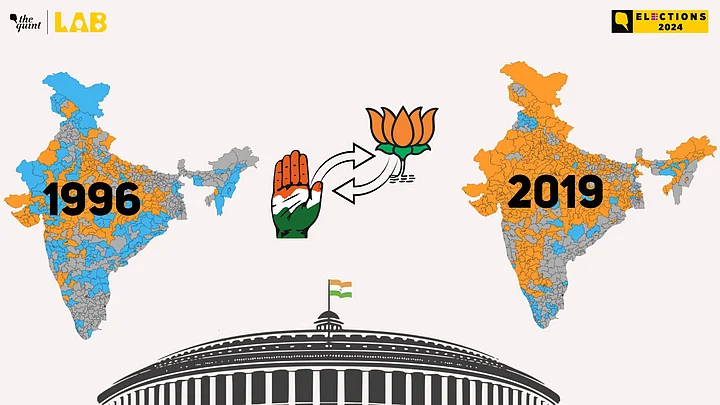Ahead of the verdict of the 2024 Lok Sabha elections, we take a look at the results of past seven parliamentary elections, from 1996 to 2019, and trace the footprints of the two leading parties – BJP and Congress – on India's map.
As the domination of Congress faded and coalition politics took over from the late 1980s, it paved way for other parties to gain grounds across the country.
Thanks to the Ram Mandir movement, the BJP emerged to be a national force. The saffron party's heft ultimately led it to become the first non-Congress party to get majority in Lok Sabha.
We trace the footprints of Congress and BJP from 1996 onwards because that was the first General Election when all 543 constituencies went to polls together. The number of Lok Sabha seats was fixed at 543 by the 1973 delimitation commission. However, in the four General Elections that followed – 1977, 1980, 1984, and 1991 – mutiny, civil unrest, and other reasons caused delays in certain constituencies and elections were not conducted on all 543 seats together.
1996 Lok Sabha Elections
The then ruling Congress could win only 140 of the 529 seats it contested, and therefore lost their government. BJP won 161 seats of the 471 it contested and formed its first government at the centre, with support from other parties. The Atal Bihari Vajpayee-led government, however, could only last 13 days.
Congress remained out of office for the following eight years.
1998 Lok Sabha Elections
BJP improved its electoral performance, winning 182 of the 338 seats it contested, signalling a high strike-rate of 53.8%. Meanwhile, Congress staggered behind, bagging 141 seats out of the 477 it contested, dropping its strike rate to 29.6%.
1999 Lok Sabha Elections
Riding high on the successes of the Kargil War and the Pokhran nuclear testing, BJP clinched 182 of the 339 seats it contested. Congress suffered another great setback securing electoral success in only 114 of the 453 seats it contested, clinching only 28.3% vote share.
2004 Lok Sabha Elections
BJP's 'India Shining' suffered an upset as it lost power by scoring just 138 seats. Congress returned to power with support from its allies of United Progressive Alliance (UPA). Congress won in 145 constituencies.
2009 Lok Sabha Elections
Congress extended one-more term in 2009 after it won in more than 200 seats after 18 years. BJP won on just 116 seats.
2014 Lok Sabha Elections
Capitalising on anti-incumbency sentiments and the ‘Modi wave’ in 2014, BJP gained a clear majority by winning 282 seats out of the 428 it contested with a vote share of 31.34% and formed the government with National Democratic Alliance (NDA).
Despite contesting on 464 seats, Congress won only 44, its lowest tally ever. Consequently, its vote share plunged to an all time low at 19.52%.
2019 Lok Sabha Elections
The following election, Congress’ vote share marginally increased to 19.67% with victories over 52 seats out of the 421 it contested. But it was BJP which won its biggest-ever mandate of 303 seats.
The change in the political landscape of the world’s largest democracy with a potential BJP victory or the possibility of Congress’ electoral comeback will be clear with Lok Sabha results on June 4.
(At The Quint, we question everything. Play an active role in shaping our journalism by becoming a member today.)
